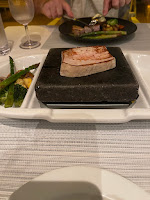April 3: Day 11. We arise to find ourselves anchored off North Seymour Island.
 |
| Early morning visitor |
 |
| Ready to go! |
After breakfast with David and Linda, we get ready and head to the base camp section and board a zodiac for our tour the island. Ernesto, our guide and the ship’s naturalist, scours the landscape as we approach the island and spots a herd of fur seals along the shoreline. He then points out a Galapagos land iguana.
 |
| Sightseeing N. Seymour |
 |
| Fur seal |
 |
| Blue-footed booby |
 |
| More boobies |
We saw lots of blue feet but were not party to the ritual. As lunchtime neared, we returned to the ship for the ceviche of the day.
While we were eating our lunch, the captain repositioned the ship to Sullivan Bay at Santiago Island.
 |
| Santiago Island |
The fourth biggest island in the archipelago, this unpopulated island was formed by two overlapping volcanoes. Sullivan Bay was formed in the second half of the 19th century by a very fluid lava flow. The afternoon’s activities included a wet landing and swimming and beach time on the island. After some relaxing leisure time on the beach, we returned to the ship and readied ourselves for a different dining experience.
 |
| Now we're cookin'! |
Tonight’s dinner would be served
alfresco on the ship’s observation deck, and the cooking would be done by
us at our table on hot lava stones. After that entertaining gastronomical experience,
we were able to observe the night sky over after dinner drinks. Because we were
virtually located on the equator, we were able to observe the night sky of the
northern and southern hemispheres simultaneously. The highlight for Capt. Larry
was that he finally saw the Southern Cross.

No comments:
Post a Comment